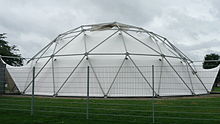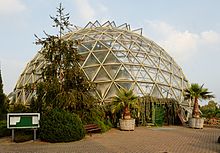Geodesic dome


Geodesic domes are constructions of spherical domes with a lattice shell made of triangles.
The term geodetic alludes to geodesy , in which the division into triangles is also essential.
history
The first modern example of a geodesic dome was the Jena Planetarium of the Carl Zeiss Works, invented by Walther Bauersfeld and opened in 1926 . Richard Buckminster Fuller developed the technology of geodesic domes from the 1940s onwards, using the term "geodesic" for the first time. The Biosphère Fuller's dome , which was shown as the US pavilion at Expo 67 in Montreal, attracted widespread attention . In the architecture of the American hippies , wooden geodesic domes became a popular construction.
advantages
Geodesic domes are characterized by their high stability ( earthquake resistance), wind stability and their favorable ratio of material to volume, they offer advantageous sound distribution and air circulation. The spherical shape also enables constant solar irradiation throughout the day, the slightest reflection of sunlight in greenhouses distributed throughout the day (and thus better energetic use in cooler seasons) and the option of distributing windows as desired. A dome can be built from metal tubes with ends pressed into flat tabs that are slightly angled and simply drilled through, and a football-shaped sphere can be built from 60 elements .
disadvantage
The 60 elements of the above example are not identical, because a geodesic half-dome consists of triangles that are joined together to form pentagons and hexagons, which results in different angles or side lengths for the triangles.
Greenhouses in the form of geodesic domes are difficult to shade or insulate with an energy screen (a greenhouse is heated by the sun for a maximum of around 8 hours in the 24 hours of a day and then cools down for around 16 hours).
construction
A geodesic dome is a convex irregular polyhedron . Therefore, Euler's polyhedron substitute applies to geodesic domes :
- Number of corners + number of faces - number of edges = 2.
|
|
For geodesic domes, dodecahedra or icosahedron , which are defined by pentagons or triangles , are usually geometrically transformed . However, it is possible to convert all Platonic solids or any polyhedron geometry into geodetic structures by dividing them into triangles .

(In geodesic dome structures engl. : Geo dome ), which are composed of triangles, give these assembled triangles both hexagons and pentagons . The number of struts that are counted from one center point of a pentagon to the center point of the next pentagon results in the so-called frequency , which is usually given in a description. For example geodesic dome with frequency 3 or frequency 4 or frequency 5 ..., correctly spelled with the addition of the Greek symbol for frequency , the lower case Ny as 3 geodesic dome or 4 or 5 ... or simplified with a "v" as 3 v or 4 v or 5 v … The higher this frequency, the rounder the polyhedron appears, as it is composed of more surfaces.
Breaking and dividing the links, or a procedure Richard Buckminster Fuller calls Jitterbug transform , results in the higher frequency geodetic forms. When subdividing, it should be noted that all corner points are best placed on the surface of a sphere (or an ellipsoid ).
See also
- Fullerenes - carbon molecules
- Eden Project
- Spaceship Earth
- Radome
- Eurosat
Web links
- Patterns of different types of domes
- Generation of geodesic domes
- Animation of the different frequencies (English)
- Instructions for building a geodesic dome yourself





